

Kyoto Wants You Back, but It Has Some Polite Suggestions
The city, one of Japan’s most-visited before the pandemic, desperately needs tourism’s money, but it would like to avoid the excesses of Instagram-driven itineraries.
Before the pandemic, Kyoto’s Kiyomizu Temple was as famous for its congestion as for its sublime architecture and spectacular view of the city below. Credit... Andrew Faulk for The New York Times
Supported by
- Share full article

By Ben Dooley and Hisako Ueno
- Published Sept. 25, 2022 Updated Sept. 28, 2022
In the months before March 2020, the food sellers in Kyoto’s Nishiki market often wished for an end to the seemingly endless stream of photo-hungry visitors from abroad who always seemed to be underfoot.
“We weren’t used to foreign tourists,” said Nobuyuki Hatsuda, who leads a business alliance promoting the shopping street in the city center, where vendors sell a dizzying array of traditional Japanese foods, carefully displayed and attractively packaged.
Nishiki has long been a working market, and the parade of visitors — rifling through the meticulously arranged merchandise, haggling with frazzled shopkeepers and blocking storefronts with their luggage — interfered with the flow of daily business, driving away locals who had long done their shopping on the street.
But then the pandemic hit. The tourists — along with their money — evaporated, and sellers had a change of heart, said Mr. Hatsuda, who sells kamaboko, a fish cake often formed into delicate pink and white loaves.
“We realized that we can’t choose our customers,” he said.
Other than China, Japan had maintained the strictest border controls of any major economy. Since the start of 2021, fewer than 800,000 foreign visitors have set foot in the country. As other countries began welcoming tourists back in numbers close to their prepandemic highs, Japan let only a trickle of travelers in. The country eased restrictions on trips for business and study in the spring, but as of September, it was still limiting tourism to travelers on package tours who were willing to negotiate a labyrinth of red tape.
That will soon change, however. Prime Minister Fumio Kishida said last week that the country would further ease border controls in October, eliminating a cap on daily entries and allowing tourists to travel independently. (Even after normal travel resumes, however, Chinese visitors, who accounted for more than 30 percent of inbound traffic in 2019, are unlikely to return in large numbers until Beijing relaxes its strict Covid Zero policy.)
As tourism slowly returns, Kyoto, like other famous tourist destinations worldwide, is grappling with how to accommodate the crowds without sacrificing quality of life for those who call the ancient capital home.
In the absence of a clear solution, Kyoto’s government is betting on a change of perspective: After years of promoting “omotenashi” — a Japanese word for meticulous hospitality — it’s trying to take more time for self-care.
“Kyoto isn’t a tourist city, it’s a city that values tourism,” Daisaku Kadokawa, the city’s mayor, said during a recent interview at its city hall, where he wore the formal kimono that has become a trademark during his almost 15 years in office.

Growing popularity
Kyoto is home to several globally known companies, like Nintendo and Kyocera, and has produced more Nobel Prize winners in the sciences than any other city in Japan. But in the years leading up to the pandemic, it had become dependent on the flood of tourists that bumped, clattered and pushed through its streets.
Kyoto had always been a popular destination for domestic travelers. Before Japan opened to the world in 1851, pilgrims trekked from around the country to visit its more than 2,000 temples and shrines. Spared from the ravages of World War II, it later became something close to a living museum, a popular destination for school trips and people hoping for a glimpse of the country’s history and tradition.
No one comes to Kyoto looking for a party. Visitors are seeking a particular vision of Japan, one that is found in the koi ponds of meticulously kept temple gardens; the smell of roasting brown tea, known as hojicha, that wafts from the door of ancient storefronts; and the clatter of a geisha’s wooden sandals down a cobbled alleyway.
In the years before the 2020 summer Olympics, however, the realities of the modern travel industry had begun to compromise the city’s anachronistic charms. Japan launched an all-out effort to promote inbound tourism, and Kyoto experienced a surge in popularity among foreign visitors.
Starting from a base of around 10 million in 2013, the number of foreign visitors had more than tripled by the pandemic’s start, according to government data . Nearly a third of them traveled to Kyoto, where the tourism industry employed one of every five workers. Taxes from the sector comprised nearly 13 percent of the city’s revenue.
But locals quickly became fed up with what they called “tourism pollution.” Suitcases jammed the aisles of city buses. Eager visitors harassed geisha’s apprentices, maiko, for photographs on their way to work. And lost tourists stumbled into people’s homes while searching for their Airbnb.
Social media, especially, shaped tourism in the city. And not for the better.
Masutami Kawaguchi, who offers private English tours of the city, said that — before the pandemic — his clients’ itineraries were almost entirely determined by Instagram. Tourism became laser-focused on the city’s famously picturesque areas, with people getting off the train at Kyoto Station and then rushing to the two or three best photo spots — the bamboo groves of Arashiyama, the orange gates winding up the mountain behind Fushimi Inari shrine and the golden pavilion at Kinkakuji temple — creating traffic jams and massive crowding in the surrounding areas.
Kyoto’s famously polite residents began to express their displeasure with uncharacteristic bluntness.
In Nishiki, signs popped up among the stalls admonishing tourists not to eat while walking, a pet peeve in Japan. Neighborhood shoppers, tired of the crowding and commotion, began going to supermarkets, and some long-established sellers closed.
Even Buddhist monks lost their cool.
In autumn and spring, when the streets became clogged with tourists gawping at pyrotechnic bursts of maple leaves and cherry blossoms, “people couldn’t even leave their houses. The city was barely livable,” said Kojo Nagasawa, the secretary general of the Kyoto Buddhist Federation, which includes three of the city’s most famous temples.
The group has long called for moderation in Kyoto’s economic development. In 1991, it took out a full-page ad in The Times opposing the construction of new, high-rise hotels, which it said would destroy the city’s unique character.
“Before we knew it, the economy was nothing but tourism,” Mr. Nagasawa said. “The city didn’t know when enough was enough.”
Looking to curb some of the worst problems, in 2018 the city cracked down on investors who were snatching up traditional houses in residential neighborhoods and converting them into Airbnb rentals.
The pandemic’s damage
In the spring of 2020, Japan slammed its borders shut. The fire hose of foreign money turned off, and Kyoto, which had long struggled with financial problems, found itself on the verge of bankruptcy.
The city got a taste of life without tourists, and the combination of the coronavirus and red ink was “a double punch,” Mr. Kadokawa, the mayor, said.
At the beginning of the pandemic, “people in the city were saying, ‘We’ve returned to the old Kyoto, isn’t that great?’” said Toshinori Tsuchihashi, the director of the city’s tourism department.
But, as the economic damage mounted, residents “have come to recognize tourism’s importance.”
Many businesses have yet to recover. Before the pandemic, it was nearly impossible to get a reservation at one of the many restaurants lining Pontocho, an atmospheric alleyway running parallel to the Kamo River in Kyoto’s city center. But on a recent weekend night, “for lease” signs hung in darkened shop windows, and many of the terraces looking out on the water sat unused.
Hotel The Mitsui Kyoto , a luxury Western-style hotel, opened in late 2020 and has operated well below capacity for most of the pandemic, according to Manabu Kusui, the general manager.
As tourists begin returning to Kyoto, the hotel hopes to differentiate itself by providing guests with exclusive experiences it has negotiated with some of Kyoto’s beautiful but less trafficked destinations. One of the first is a private tour of Nijo Castle, the residence of Japan’s first shogun of the Edo period, Tokugawa Ieyasu, conveniently located next to the hotel.
It’s a style of tourism the city is trying to promote as part of its new strategic plan to address prepandemic crowding.
But Mr. Kusui knows that people come to Kyoto with a certain itinerary in mind, and “we can’t tell them not to go to some place like Kiyomizu Temple,” he said, referring to the famous Buddhist temple perched on a mountain face on Kyoto’s east side.
Some polite suggestions
With no legal options for instituting hard limits on visitors, the government hopes to dilute traffic so it is less concentrated in the same times and places. Planners are also discussing how to fix problems, like crowded city buses, that aggravate residents. So far, however, the initiatives mostly consist of soft measures like trying to educate visitors in Kyoto’s traditional “morals” and hoping for the best.
In that spirit, Nishiki market has decided it will try to encourage tourists instead of admonishing them, exchanging its list of “don’ts” for a list of “pleases.” Visitors who scan a large QR code at the entrance are presented with a list of suggestions for enjoying the market and rewarded with free Wi-Fi for reading it.
At the same time, many in the city are trying to improve the experience for tourists and residents alike by reimagining Kyoto’s overall approach to the industry.
Kiyomizu Temple is among the institutions that have taken up the gauntlet, trying to promote a new kind of tourism that encourages tourists to think of the city as a place to live, not a theme park.
Before the pandemic, the temple was as famous for its congestion as for its sublime architecture and its spectacular view of the city below. In high season, pushing through the crowds clogging the temple’s graceful walkways had become an enervating and dispiriting ordeal that few locals would willingly undergo.
When Covid hit, the temple's abbot, Seigen Mori, was already experimenting with ways to allow visitors to experience it as it was intended — as a tranquil place of worship — but with limited success.
The last two and a half years, however, have given him an opportunity to “press reset,” he said, and explore different ways of interacting with visitors. In recent months he has begun opening the temple at night to small groups, taking the time to personally lead them in prayer and conversation.
Seeing the temple at night fundamentally transforms visitors’ relationship with the space, he believes, as the disorienting press of the usual crowds is replaced with the chirr of cicadas, the rich aroma of incense and the soft flicker of shadows on ancient statuary.
Mr. Mori is eager to welcome guests from abroad, he said, as long as they understand that the experience is focused on contemplation.
Kyoto is anticipating the inevitable return of those guests with a mix of longing and apprehension, said Takeshi Otsuki, a general manager at Japanese travel giant JTB.
“We’re hoping the number of visitors increases gradually, and we have a soft landing,” Mr. Otsuki said.
Some in the city are eager to greet the new tourists.
Fuminari Shinbo is part of a group of retirees who began training ahead of the Tokyo Olympics to give English tours to visitors coming to Kyoto, devoting hours to memorizing English dialogues they never had the chance to use.
In late August, about 20 of the volunteers eagerly gathered in front of Fushimi Inari, a shrine that has become Kyoto’s most popular tourist destination, for a dry run.
Clothed in bright blue bibs with white lettering advertising free help for English-speaking tourists, they introduced the shrine’s most famous feature, a corridor of nearly a thousand bright orange gates that have provided a vibrant punch of color to countless vacation photos.
When the tour was over, Mr. Shinbo said he was excited that he would finally be able to put his hard work to good use.
So far, he said, “I’ve only been able to practice on my grandson.”

52 Places for a Changed World
The 2022 list highlights places around the globe where travelers can be part of the solution.
Follow New York Times Travel on Instagram , Twitter and Facebook . And sign up for our weekly Travel Dispatch newsletter to receive expert tips on traveling smarter and inspiration for your next vacation. Dreaming up a future getaway or just armchair traveling? Check out our 52 Places for a Changed World for 2022.
An earlier version of this article misidentified Tokugawa Ieyasu. He was the first shogun of the Edo period. He was not the first shogun of Japan. The error was repeated in a photo caption.
An earlier version of this article spelled the name of a tourist site popular on Instagram incorrectly. It is the golden pavilion at Kinkakuji temple, not at Kinkauji temple.
How we handle corrections
Ben Dooley reports on Japan’s business and economy, with a special interest in social issues and the intersections between business and politics. More about Ben Dooley
Hisako Ueno has been reporting on Japanese politics, business, gender, labor and culture for The Times since 2012. She previously worked for the Tokyo bureau of The Los Angeles Times from 1999 to 2009. More about Hisako Ueno
Advertisement
We’re sorry, this site is currently experiencing technical difficulties. Please try again in a few moments. Exception: request blocked
- About Japan
Visiting Japan
- Information Related to COVID-19 - JapanGov
- Border enforcement measures to prevent the spread of novel coronavirus (COVID-19) - Ministry of Foreign Affairs of Japan
- TeCOT (COVID-19 Testing Center for Overseas Travelers) - Ministry of Economy, Trade and Industry
- Vaccination Certificate for Overseas Travel - Ministry of Health, Labour and Welfare
- Novel Coronavirus (COVID-19) - Ministry of Health, Labour and Welfare
- Coronavirus (COVID-19) advisory information - Japan National Tourism Organization
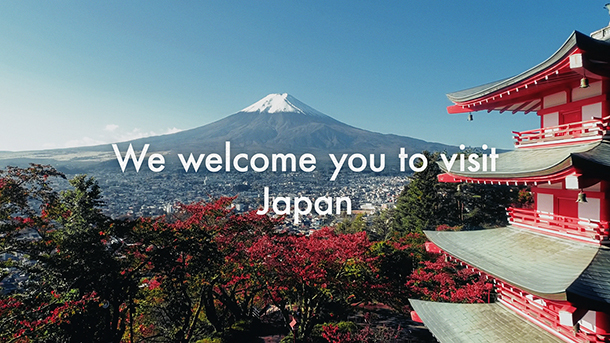
We welcome you to visit Japan
Empowering the Disabled
This movie introduces the new essential steps ahead of an unforgettable travel in Japan.
General Information
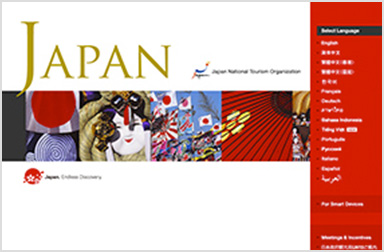
Japan: the Official Guide
Japan National Tourism Organization
General tourism information of Japan in multi languages. Climate, Healthcare, Money, Visa, Emergency info, etc. WEB: http://www.jnto.go.jp/
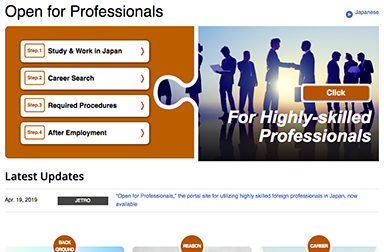
Open for Professionals
Japan External Trade Organization
The Government of Japan strongly welcomes highly-skilled foreign professionals. WEB: https://www.jetro.go.jp/en/hrportal/
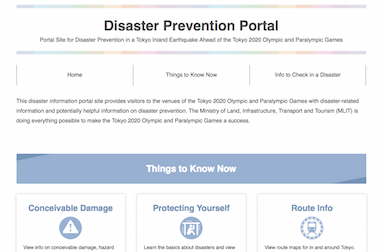
Disaster Prevention Portal
Ministry of Land, Infrastructure, Transport and Tourism
Portal Site for Disaster Prevention in a Tokyo Inland Earthquake Ahead of the Tokyo 2020 Olympic and Paralympic Games. WEB: http://www.mlit.go.jp/en/
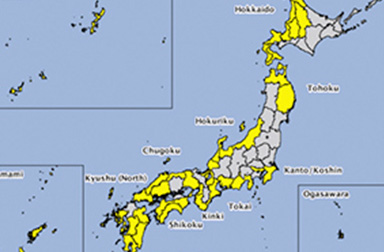
Safety Tips
Safety tips is an app to push notify the disaster information of Japan. Download the app from the website as follow; WEB: http://www.jnto.go.jp/safety-tips/
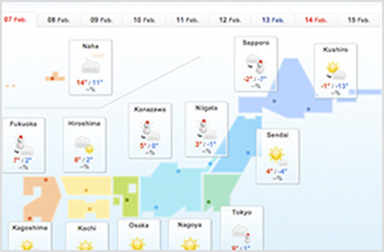
Japan Weather Forecast for Travelers
Weather forecast in English for travelers. WEB: http://www.jnto.go.jp/weather/eng/index.php
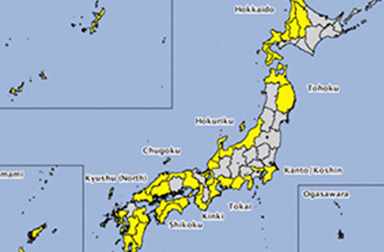
Japan Meteorological Agency
WEB: http://www.jma.go.jp/jma/indexe.html
Embassies, Visas, Customs and other Tourism Related Information
- Japanese Embassies, Consulates and Permanent Missions Overseas [Ministry of Foreign Affairs]
- Visas – Guide to Japanese Visas – [Ministry of Foreign Affairs]
- Customs – Procedures of Passenger Clearance – [Japan Customs]
- The Working Holiday Programmes in Japan [Ministry of Foreign Affairs]
- Animal Quarantine [Ministry of Agriculture, Forestry and Fisheries]
- Plant Protection Station [Ministry of Agriculture, Forestry and Fisheries]
Studying and Teaching
- Study in Japan Comprehensive Guide [Ministry of Foreign Affairs]
- Gateway to study in Japan [Japan Student Services Organization]
- Erin's Challenge! I can speak Japanese [The Japan Foundation]
- Marugoto: Japanese Language and Culture [The Japan Foundation]
- Portal Site on Policies for Foreign Residents [Cabinet Office]
- The Japan Exchange and Teaching Programme (JET)
Japan is swamped with tourists. Now visitors are going off the beaten track
Tour operators are touting Japan’s less explored regions as surging visitor numbers put strain on popular sites.

Tokyo, Japan – When Paul Christie started conducting tours on Japan’s Nakasendo, an old trade route along the post towns of Nagano Prefecture’s Kiso Valley, few travellers frequented the trail.
Christie, who has lived on and off in Japan since the late 1980s, viewed the route as a great opportunity for tourists to see a more authentic side of Japan, allowing them to explore the country’s history, nature and geography on foot.
Keep reading
India hosts g20 tourism meet in kashmir under heavy security, saudi arabia eyes aviation expansion to get in on crucial tourism market, are the risks involved in sea and space tourism too high, ‘without rules we cannot live’: greece seeks ways to tackle ‘overtourism’.
Since taking over as CEO of tour operator Walk Japan in 2002, Christie has been on a mission to spread tourists more evenly across the archipelago.
“We’ve been doing this for 20 years and we tend to go to places that are not touristy, so we’re teasing out the interesting parts of Japan,” the United Kingdom native told Al Jazeera.
“This addresses the problems Japan is experiencing with ‘overtourism’.”

“Overtourism” was a common talking point in Japan’s tourism industry before the COVID-19 pandemic.
After eight consecutive years of inbound growth, Japan received a record 32 million visitors in 2019.
But the rising tide did not raise all boats. Most travellers flocked to the Golden Route, running from Tokyo through the Osaka-Kyoto-Kobe conurbation, putting historical districts, Shinto shrines, Buddhist temples and popular museums under strain.
Since Japan lifted its pandemic-era border restrictions in October last year, concerns about unsustainable tourism have returned.
Visitors have rushed back in droves: 2.3 million foreign tourists arrived in July, the highest figure for any month since 2019.
China’s decision last month to lift its three-year ban on group tours to Japan is expected to result in a further spike in arrivals.
In 2019, 9.2 million Chinese tourists travelled to Japan, accounting for nearly one-third of all visitors, spending 1.8 trillion yen ($12.2bn) in the process.
“Our head office is located in the centre of Kyoto and we feel there are as many tourists as before COVID,” Hiroshi Kawaguchi, the general manager at tour operator Oku Japan, told Al Jazeera.
“This is a similar situation where major sightseeing spots are overcrowded and public buses are lining up.”
Though Kawaguchi says his company’s vision is not focused on alleviating overtourism, Oku Japan’s business model is attuned to such concerns.
“The main part of our itineraries are off the beaten track,” Kawaguchi told Al Jazeera.
“More importantly, every tour we offer includes the element of community interactions… We call these experiences fureai, and this is particularly important not only for the enjoyment of clients but also the local community.”

Tour operators focused on less-explored regions also believe in the power of tourism to have a positive impact on rural communities and spur chiho-sosei, or regional revitalisation.
In 2007, Walk Japan launched the Community Project to reinvigorate two neighbouring valleys on the Kunisaki Peninsula, where the company is based.
Alongside conducting group tours in the region, Walk Japan carries out development projects, from helping local farmers cultivate rice and shiitake mushrooms, to providing English education for schoolchildren and refurbishing old buildings.
Revitalisation is “part of the company DNA,” Christie said.
“We want to provide an example of what’s possible and perhaps inspire others.”
As Japan’s population greys, many small villages are on the brink of extinction. For such communities, tourism can be a welcome and much-needed rejuvenating force.
“With the right support, some communities genuinely want [tourists] to experience their hospitality and their local lifestyles and find out about their region, as long as they aren’t overwhelmed by visitors and the quality of life isn’t degraded,” Alex Bradshaw, founder and chief consultant at travel and tourism consultancy Gotoku, told Al Jazeera.
“Even if a village doesn’t survive into the future, the fact that it’s been remembered by somebody is incredibly powerful; that people lived here and they had this lifestyle and we shared a little time together. That kind of human interaction is very important.”
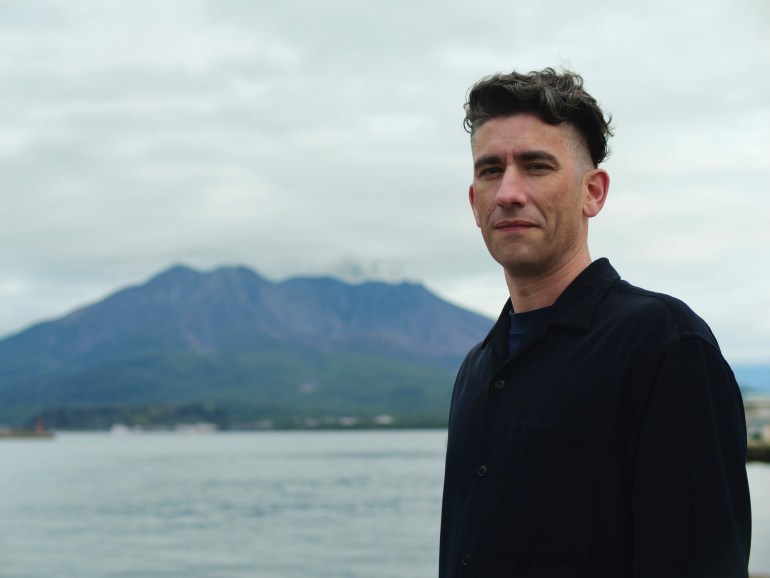
Overtourism is not restricted to Japan’s urban areas.
Rural World Heritage sites, subtropical islands, popular hiking trails and national parks have also been negatively affected.
Fuji-Hakone-Izu, for example, receives nearly half of all national park visitors in Japan, owing to its proximity to Tokyo and as the site of Mount Fuji.
Michelle Lyons, founder of Point North, a specialist branding firm supporting businesses passionate about Japanese culture, is working on a campaign to spread tourism – and its economic benefits – more equitably among Japan’s 34 national parks.
“I wanted to find a way to promote all the parks as though it’s a network of destinations that are all equal to each other,” Lyons told Al Jazeera.
“And by presenting them in this way I’m hoping the more popular parks will help raise the profile of the less popular parks.”
Lyons is developing collectable pins and patches for each park and a trading card game. She wants these collectable souvenirs to showcase the individual merits of each park and serve as educational tools.
“The management of the parks is really fragmented, so it’s difficult for them to coordinate their efforts… There needs to be a series of different solutions that creates value for the unique groups involved; a blanket approach isn’t going to work,” she said.
“In terms of increasing expenditure in the parks, gift shops could play a big part in that if they’re more strategic with what they’re selling, and think about what tourists actually want and find appealing.”
Stereotypical images
It’s a common refrain in the industry that Japan does not understand how to market itself to foreign travellers but Bradshaw thinks Western media is also at fault for presenting stereotypical images of the country.
“I see how Japan is presented and I’m kind of confused by it. I just wonder what part of Japan that is, because they do rely on the kitsch, the odd side of it, or culture tropes… It’s all maid cafés, geisha, tea ceremonies and ninja,” he said.
“It would be my hope that people would find a deeper side of Japan. But I understand why that is difficult for the tourism industry as well. When you’ve got to prioritise what sells as opposed to what’s authentic and necessarily good for regional communities.”
Some areas have implemented initiatives to specifically tackle overcrowding.
Kyoto, known as Japan’s cultural capital, is set to abolish its One-Day Bus Pass for tourists, sales of which will cease in October.
Iriomote, widely feted as the most beautiful of the Ryukyu Islands, has limited the number of daily visitors to 1,200.
In Yamanashi Prefecture, the local government has considered restricting the number of hikers on Mt Fuji’s Yoshida trail if it becomes too congested.
Last month, Prime Minister Fumio Kishida announced that the government would devise nationwide countermeasures to mitigate overtourism this autumn.
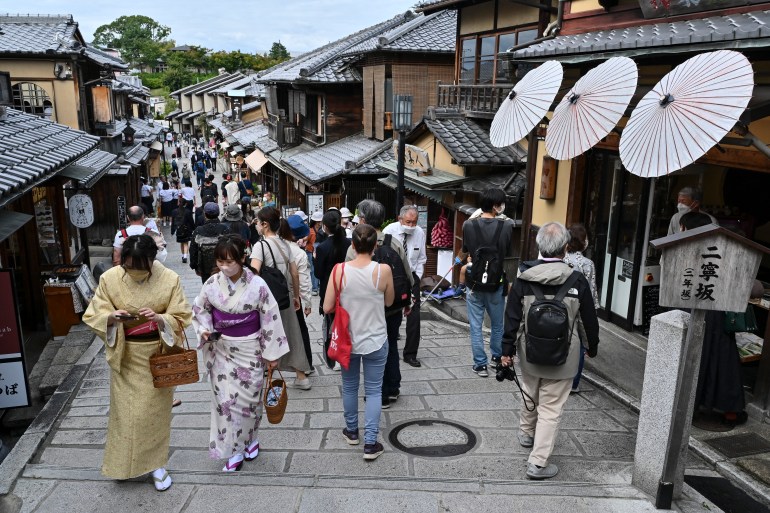
Kumi Kato, a tourism professor at Wakayama and Musashino universities, said the government has made moves in the right direction – such as organising cross-ministry meetings on spreading the benefits of tourism – but there is much work to be done.
“Destination wellbeing should be the goal and benchmarking concept,” Kato told Al Jazeera.
“Promoting the night and early morning economy and secondary destinations will disperse tourism into regional areas but that alone cannot lead to successful regional tourism.”
“It’s critical that the target should be clearly set… high-end tourists, or tourists with wealth, are often talked about, but it should not be misunderstood that only wealthy tourists are valuable,” Kato added.
“Value should be added to high-quality products and authentic experiences [which will] raise visitor spending rather than increase numbers. The government does set a target stay – number of days – and spending per visitor, but strategically ‘what kind of tourists’ should be clearer.”
Update April 12, 2024
Information for u.s. citizens in the middle east.
- Travel Advisories |
- Contact Us |
- MyTravelGov |
Find U.S. Embassies & Consulates
Travel.state.gov, congressional liaison, special issuance agency, u.s. passports, international travel, intercountry adoption, international parental child abduction, records and authentications, popular links, travel advisories, mytravelgov, stay connected, legal resources, legal information, info for u.s. law enforcement, replace or certify documents.
Before You Go
Learn About Your Destination
While Abroad
Emergencies
Share this page:
Travel Advisory January 8, 2024
Japan - level 1: exercise normal precautions.
Japan – Level 1: Exercise Normal Precautions
Reissued after periodic review without changes.
Exercise normal precautions in Japan.
Read the country information page for additional information on travel to Japan.
If you decide to travel to Japan:
- Enroll in the Smart Traveler Enrollment Program (STEP) to receive Alerts and make it easier to locate you in an emergency.
- Follow the Department of State on Facebook and Twitter .
- Follow Embassy Tokyo’s American Citizen Services section on Facebook and Twitter .
- Review the Country Security Report for Japan.
- Visit the CDC page for the latest Travel Health Information related to your travel.
- Prepare a contingency plan for emergency situations. Review the Traveler’s Checklist .
Embassy Messages
View Alerts and Messages Archive
Quick Facts
Duration of intended period of stay. Please note you cannot travel on a passport you have previously declared as lost or stolen even if you subsequently locate it
One page required for entry stamp
Amounts equivalent to ¥1,000,000 or above subject to declaration
Embassies and Consulates
U.S. Embassy Tokyo 1-10-5 Akasaka, Minato-ku, Tokyo 107-8420 Japan Telephone: 81-3-3224-5000 Emergency After-Hours Telephone: 81-3-3224-5000 Fax: 81-3-3224-5856 Our Navigator Assistant will guide you to the information you need.
U.S. Consulate General Osaka-Kobe 2-11-5, Nishitenma, Kita-ku, Osaka 530-8543, Japan Telephone: 81-6-6315-5900 Emergency After-Hours Telephone: 81-3-3224-5000 Fax: 81-6-6315-5914 Our Navigator Assistant will guide you to the information you need.
U.S. Consulate General Naha 2-1-1 Toyama, Urasoe City, Okinawa, Japan Telephone: 81-98-876-4211 Emergency Telephone: 81-3-3224-5000 Fax: 81-98-876-4243 Our Navigator Assistant will guide you to the information you need.
U.S. Consulate General Sapporo Kita 1-jo Nishi 28-chome, Chuo-ku, Sapporo 064-0821, Japan Telephone: 81-11-641-1115 Emergency After-Hours Telephone: 81-11-641-1115 Fax: 81-11-643-1283 Our Navigator Assistant will guide you to the information you need. All assistance at the Consulate General Sapporo is by appointment only.
U.S. Consulate Fukuoka 5-26 Ohori 2-chome, Chuo-ku, Fukuoka 810-0052, Japan Telephone: 81-92-751-9331 Emergency After-Hours Telephone: 81-3-3224-5000 Fax: 81-92-713-9222 [email protected] Our Navigator Assistant will guide you to the information you need. Routine services are provided by appointment only.
U.S. Consulate Nagoya Nagoya International Center Bldg. 6th floor, 1-47-1 Nagono, Nakamura-ku, Nagoya 450-0001, Japan Telephone: 81-52-581-4501 Emergency After-Hours Telephone: 81-3-3224-5000 Fax: 81-52-581-3190 Our Navigator Assistant will guide you to the information you need. Emergency services are provided by U.S. Consulate General Osaka-Kobe.
Destination Description
See the Department of State’s Fact Sheet on Japan for information on U.S-Japan relations.
Entry, Exit and Visa Requirements
Visit the Embassy of Japan website for the most current visa information.
There are no COVID-related entry requirements for U.S. citizens.
Entry & Exit:
- You must have a valid passport and an onward/return ticket for tourist/business "visa free" stays of up to 90 days. Your passport must be valid for the entire time you are staying in Japan.
- You cannot work on a 90-day "visa free" entry.
- "Visa free" entry status may not be changed to another visa status without departing and then re-entering Japan with the appropriate visa, such as a spouse, work, or study visa.
- Visit the Embassy of Japan website for the most current information on all visa categories.
- Japanese immigration officers may deny you entry if you appear to have no visible means of support.
- All foreign nationals are required to provide fingerprint scans and to be photographed at the port of entry. Exceptions to this requirement include diplomatic and official visa holders, minors, and individuals covered under SOFA Article IX.2. For further information about landing procedures, please visit the Immigration Bureau of Japan’s website .
- Make sure your passport is valid. Note you cannot travel on a passport you have previously declared as lost or stolen even if you subsequently locate it. Japanese authorities will likely deny you entry into Japan if you attempt to do so. If you have reported your passport lost or stolen, you must apply for a new passport before travel.
Transiting Japan:
- Ensure that your passport and visa are valid and up-to-date before you leave the United States. Passport services are not available at the airport.
- Airlines in Japan may deny you boarding for transit if you do not have the required travel documents for an onward destination in another country or if your passport does not have six months of validity remaining. For the entry requirements of the country you are traveling to, visit the State Department's Country Specific Information website.
Military/SOFA Travelers: While active-duty U.S. military personnel may enter Japan under the Status of Forces Agreement (SOFA) with proper Department of Defense (DoD) identification and travel orders, all SOFA family members, civilian employees, and contractors must have valid passports to enter Japan. Please consult the DOD Foreign Clearance Guide before leaving the United States.
See the Immigration Bureau of Japan’s website for various immigration procedures.
HIV/AIDS Restrictions: The U.S. Department of State is unaware of any HIV/AIDS entry restrictions for visitors to or foreign residents of Japan.
Find information on dual nationality , prevention of international child abduction and customs regulations on our websites.
Safety and Security
For police services in Japan, dial 110. For fire or ambulance services, dial 119.
Crime: Crime against U.S. citizens in Japan is generally low and usually involves personal disputes, theft, or vandalism. In addition:
- Robberies committed after a victim has been drugged from a spiked drink can occur, especially in nightlife districts.
- Sexual assaults are not often reported, but they do occur, and victims may be randomly targeted. Victim's assistance resources or shelters are difficult for foreigners to access.
- Hate-related violent crimes rarely occur, although some U.S. citizens have reported being the target of discrimination because of their nationality or their race.
- Pick pocketing can occur in crowded shopping areas, on trains, and at airports.
- Police reports must be filed before leaving Japan, as Japanese police will not accept reports filed from overseas.
- In instances involving credit card theft or fraud, Japanese police often provide a report number rather than a police report. You can provide this report number to your credit card company to confirm the incident with the police.
Entertainment and Nightlife Districts in Tokyo:
- Exercise caution in all entertainment and nightlife districts throughout Japan, especially Roppongi, Kabuki-cho, Shibuya, and Ikebukuro.
- Incidents involving U.S. citizens in these areas include physical and sexual assaults, drug overdoses, theft of purses, wallets, cash and credit cards at bars or clubs, and drugs slipped into drinks.
- Drink spiking at bars and entertainment venues, especially in areas such as Roppongi and Kabuki-cho, near Shinjuku, has led to robbery, physical and sexual assaults, and credit card fraud. Some victims regain consciousness in the bar or club; other victims may awaken on the street or other unfamiliar locations.
- U.S. citizens have reported being threatened with gun or knife violence in such venues so that they will pay exorbitant bar tabs or withdraw money. U.S. citizens have also reported being beaten when they have refused to pay or hand over money.
- There have been reports of U.S. citizens being forcibly taken to ATMs and robbed, or made to withdraw funds after being unable to pay exorbitant bar tabs.
- Please be aware that Roppongi, Kabuki-cho, and other entertainment and nightlife districts have also been the scenes of violence between criminal syndicates.
See the Department of State and the FBI pages for information on scams.
Police reports must be filed at the nearest police station prior to departure from Japan. The Japanese police cannot accept reports filed from overseas. Report crimes to the local police at 110 and contact the U.S. Embassy at 03-3224-5000 (011-81-3-3224-5000 from overseas). Remember that local authorities are responsible for investigating and prosecuting the crime.
See our webpage on help for U.S. victims of crime overseas .
- help you find appropriate medical care;
- assist you in reporting a crime to the police;
- contact relatives or friends with your written consent;
- explain the local criminal justice process in general terms;
- provide a list of local attorneys;
- provide information on victim’s compensation programs in the U.S. ;
- provide an emergency loan for repatriation to the United States and/or limited medical support in cases of destitution
- help you find accommodation and arrange flights home; and/or
- replace a stolen or lost passport.
Contacting Police, Fire and Ambulance Services: You can reach the police throughout Japan by dialing 110. Fire and ambulance services can be contacted by dialing 119. Note that English-speaking dispatchers may not be available. Please review advice on “Calling for Help” on our website . If you need assistance, you should be able to describe your address/location in Japanese or find someone who can do so, since few police officers speak English.
Domestic Violence: Victim's assistance resources or battered women's shelters exist in major urban areas, but are difficult for foreigners to access. These types of resources are also generally unavailable in rural areas. Investigations of sexual assault crimes are often conducted without female police officers present, and police typically ask about the victim's sexual history and previous relationships.
Tourism: The Victim's assistance resources or battered women's shelters exist in major urban areas, but are difficult for foreigners to access. These types of resources are also generally unavailable in rural areas. Investigations of sexual assault crimes are often conducted without female police officers present, and police typically ask about the victim's sexual history and previous relationships.
See our webpage for more information on insurance providers for overseas coverage.
Local Laws & Special Circumstances
Criminal Penalties: You are subject to Japanese law while you are in Japan. If you violate Japanese laws, even unknowingly, you may be arrested, imprisoned, or deported. If you are arrested in Japan, even for a minor offense , you may be held in detention without bail for several months or more during the investigation and legal proceedings.
Some offences are also prosecutable in the United States, regardless of Japanese law. For examples, see our website on crimes against minors abroad and the Department of Justice website.
The vast majority of arrests of U.S. citizens in Japan are for drug-related offenses. Japanese authorities aggressively pursue drug smugglers and users, including recreational users with sophisticated detection equipment, "sniffing" dogs, blood tests, “stop and frisk” tactics, and other methods. Penalties for possessing, using, or trafficking a drug that is illegal in Japan are severe, and convicted offenders can expect long jail sentences and fines. Please note that some drugs which may be legal in certain jurisdictions outside of Japan, including marijuana and synthetic drugs, remain illegal in Japan. This also applies to certain prescription drugs that doctors in the United States may prescribe. Japanese law makes no distinction between medical and recreational marijuana; therefore, having a prescription for medical marijuana will not help you avoid arrest or prosecution. Even possession of a small amount of marijuana for personal medical or recreational use can result in a long jail sentence and fine. Japanese customs officials carefully screen incoming packages, and individuals who are mailed drugs can be arrested and prosecuted as drug traffickers.
Confiscation of Prescription Drugs and Other Medication: It is important to note that some medications that are routinely prescribed in the United States, including Adderall and marijuana, are strictly prohibited in Japan. The Japanese government decides which medications may be imported legally into Japan. The Embassy and Consulates of Japan in the United States have limited information available and do not have a comprehensive list of specific medications or ingredients. Please see more information on importing medicines into Japan.
You must carry your U.S. passport or Japanese Residence Card (Zairyu Kado) with you at all times. In Japan, you may be taken in for questioning if you do not have your passport or Japanese residence card to show your identity and status in Japan (e.g., as a visitor, student, worker, or permanent resident).
It is illegal to work in Japan while in tourist or visa-waiver status. Overstaying your visa or working illegally may lead to fines of several thousands of dollars, and in some cases, re-entry bans as long as 10 years, or indefinitely for drug offenders. For additional information, please see Japan’s Immigration Control and Refugee Recognition Act and contact the Japanese Embassy or nearest Japanese Consulate in the United States for more information.
Driving under the influence of alcohol could also land you immediately in jail. The blood-alcohol limit in Japan is 0.03%. Punishments can be up to 10,000 USD in fines and up to five years in prison.
Possession of a gun or ammunition is a crime in Japan. Carrying a knife with a locking blade, or a folding blade that is longer than 5.5 cm (a little more than two inches), is illegal in Japan. U.S. citizens and U.S. military personnel have been arrested and detained for more than 10 days for carrying pocket knives that are legal in the United States but illegal in Japan. The possession of lock-picking tools is illegal in Japan.
Establishing a Business : Individuals establishing a business or practicing a profession that requires additional permits or licensing should seek information from the competent local authorities, prior to practicing or operating a business.
A list of English-speaking lawyers located throughout Japan is available on our website .
Arrest Notification : If you are arrested or detained, ask police or prison officials to notify the U.S. Embassy immediately. See the Department of State’s webpage and the Embassy’s website for additional information.
Counterfeit and Pirated Goods: Although counterfeit and pirated goods are prevalent in many countries, they may still be illegal according to local laws. You may also pay fines or have to give them up if you bring them back to the United States. See the U.S. Department of Justice’s website for more information .
Faith-Based Travelers: See our following webpages for details:
- Faith-Based Travel Information
- International Religious Freedom Report – see country reports
- Human Rights Report – see country reports
- Hajj Fact Sheet for Travelers
- Best Practices for Volunteering Abroad
LGBTQI+ Travelers: There are no legal restrictions on same-sex sexual relations or the organization of LGBTI+ events in Japan.
Laws governing rape, sexual commerce, and other activity involving sexual relations do not apply to same-sex sexual activity. This leads to lower penalties for perpetrators of same-sex rape and sexual assault and greater legal ambiguity surrounding same-sex prostitution.
See our LGBTQI+ Travel Information page and section 6 of our Human Rights report for further details.
Travelers with Disabilities: The law in Japan prohibits discrimination against persons with disabilities. Japanese disability laws require the public sector to provide reasonable accommodations and the private sector to make best efforts in employment, education, access to health care, or the provision of other services; however, there are no penalties for noncompliance. Social acceptance of persons with disabilities in public is not as prevalent as in the United States.
Although Japan’s accessibility laws mandate that new construction projects for public use include provisions for persons with disabilities, older buildings are not likely to have been retrofitted for accessibility. At major train stations, airports, and hotels, travelers with disabilities should encounter few accessibility problems. Note that many smaller stations are inaccessible to those who cannot climb stairs. Information on travel in Japan for travelers with disabilities is available at Accessible Japan .
Travelers with disabilities can learn more about resources available in country from the Japan National Tourism Organization’s traveling with a disability page .
Students: See our Students Abroad page and FBI travel tips .
Women Travelers: See our travel tips for Women Travelers .
Conditions at Prisons and Detention Facilities: Japanese prisons and detention facilities maintain internal order through a regime of very strict discipline. U.S. citizen prisoners often complain of stark, austere living conditions and psychological isolation. Heating in winter can be inadequate in some facilities, food portions can be significantly smaller than what many may be accustomed to, and access to specialized medical care, particularly mental health care, at detention facilities and prisons is sometimes limited. Additional information on arrests in Japan is available on our embassy website.
Customs Regulations: Please contact the Japanese Embassy or nearest Japanese consulate in the United States, or visit the Japanese Customs website for specific information regarding import restrictions and customs requirements.
Japanese customs authorities encourage the use of an Admission Temporaire/Temporary Admission (ATA) Carnet in order to temporarily import professional equipment, commercial samples, and/or goods for exhibitions and trade fairs into Japan. For additional information, please call (212) 354-4480, or email the U.S. CIB for details.
Pets: The Japanese Animal Quarantine Service (AQS) sets procedures for importing pets. At a minimum, the process will take seven to eight months, though the process can take up to a year before a pet may enter Japan. Advance planning is critical. You can find more information about importing a pet into Japan or information about exporting a pet from Japan on our Embassy website.
Employment Issues: U.S. citizens should not come to Japan to work without having the proper employment visa arranged ahead of time. Teaching English, even privately, and serving as hosts/hostesses are both considered "work" in Japan and are illegal without the proper visa.
Some U.S.-based employment agencies and Japanese employers do not fully or correctly represent the true nature of employment terms and conditions. A minimum requirement for effectively seeking the protection of Japanese labor law is a written and signed work contract. If there is no signed contract, Japanese authorities are not able to act on behalf of foreign workers. If you are coming to Japan to work, carefully review your contract and the history and reputation of your Japanese employer before traveling to Japan. Complaints against U.S.-based employment agencies or recruiters may be directed to the Better Business Bureau or the Office of the Attorney General in the relevant state(s).
Disaster Preparedness : Japan is prone to natural disasters, including earthquakes, typhoons, tsunamis, and landslides. See the Embassy’s webpage for recommendations and steps you can take to prepare for an emergency. The Japan Tourism Organization’s Safety Tips app and NHK World app provide Japanese government emergency “J-Alerts” to your cell phone in English through push notifications. “J-Alerts” can provide early warning emergency alerts on earthquakes predicted in a specific area, sometimes seconds before an earthquake hits.
Radiation: Fukushima Daiichi Nuclear Power Plant : The Government of Japan continues to closely monitor the conditions at and around the Fukushima Daiichi Nuclear Power Plant. You should comply with all travel restrictions and cautions put into place by the Government of Japan for areas surrounding the plant. For more information, contact the Japan Nuclear Regulation Authority .
For police service in Japan, dial 110. For fire or ambulance, dial 119.
Ambulance services are widely available but receiving hospitals may decline to accept inbound patients unless they can provide proof of funds to pay for services.
COVID-19 Testing:
- Travelers should contact Japanese local health providers to determine the location of testing facilities within Japan. A non-comprehensive list of some COVID-19 testing facilities can be found here on the Embassy website.
COVID-19 Vaccines:
- The COVID-19 vaccine is available for U.S. citizens to receive in Japan.
- Review the Government of Japan’s English language website on COVID-19 vaccinations in Japan.
- Visit the FDA's website to learn more about FDA-approved vaccines in the United States.
The Department of State does not pay medical bills. Be aware that U.S. Medicare/Medicaid does not apply overseas. Most hospitals and doctors overseas do not accept U.S. health insurance.
Medical Insurance: Make sure your health insurance plan provides coverage overseas. Some care providers in Japan only accept cash payments. See our webpage for more information on insurance providers for overseas coverage. Visit the U.S. Centers for Disease Control and Prevention for more information on type of insurance you should consider before you travel overseas.
We strongly recommend supplemental insurance to cover medical evacuation.
If traveling with prescription medication, check with the government of Japan’s Ministry of Health website to ensure the medication is legal in Japan; possession, use, or importation of a prescription drug that is illegal in Japan may result in arrest and criminal prosecution. Always carry your prescription medication in original packaging with your doctor’s prescription. U.S. prescriptions are not honored in Japan, so if you need ongoing prescription medicine, you should arrive with a sufficient supply for your stay in Japan or enough until you are able to see a local care provider.
Vaccinations: Be up-to-date on all vaccinations recommended by the U.S. Centers for Disease Control and Prevention.
Further health information:
- World Health Organization
- U.S. Centers for Disease Control and Prevention (CDC)
Japan has a national health insurance system which is available only to those foreigners with long-term visas for Japan. National health insurance does not pay for medical evacuation. Medical caregivers in Japan may require payment in full at the time of treatment or concrete proof of ability to pay before they will treat a foreigner who is not a member of the national health insurance plan.
U.S.-style and standard psychological and psychiatric care can be difficult to locate outside of major urban centers in Japan and generally is not available outside of Japan's major cities. Extended psychiatric care can be very difficult to obtain.
Air Quality: Visit AirNow Department of State for information on air quality at U.S. Embassies and Consulates.
Travel and Transportation
Road Conditions and Safety : Driving in Japan can be complicated and expensive. Traffic moves on the left side of the road. Those who cannot read the language will have trouble understanding road signs. Highway tolls can be very high, and city traffic is often very congested. A 20-mile trip in the Tokyo area may take two hours. There is virtually no legal roadside or curbside parking; however, traffic is commonly blocked or partially blocked by those illegally parked curbside. In mountainous areas, roads are often closed during the winter, and cars should be equipped with tire chains. Roads in Japan are much narrower than those in the United States.
Traffic Laws : Japanese law provides that all drivers in Japan are held liable in the event of an accident, and assesses fault in an accident on all parties. Japanese compulsory insurance (JCI) is mandatory for all automobile owners and drivers in Japan. Most short-term visitors choose not to drive in Japan. Turning right or left on red lights is not permitted in Japan, and all passengers are required to fasten their seat belts.
Japan has a national 0.03 percent blood-alcohol-level standard for driving, and drivers stopped for driving under the influence of intoxicants will have their licenses confiscated. If you are found guilty of driving under the influence, speeding, or blatantly careless driving resulting in injury, you are subject to up to 15 years in prison.
See our Road Safety page for more information. The National Police Agency (NPA) oversees the administration and enforcement of traffic laws in Japan. You can find further information in English on the NPA English website . Information about roadside assistance, rules of the road, and obtaining a Japanese driver's license is available in English from the Japan Automobile Federation (JAF) web site . See the Japan National Tourism Organization’s website for car rental and driving in Japan.
Emergency Assistance : For roadside assistance, please contact the Japan Automobile Federation (JAF) at 03-5730-0111 in Tokyo, 072-645-0111 in Osaka, 011-857-8139 in Sapporo, 092-841-5000 in Fukuoka, or 098-877-9163 in Okinawa.
International Driving Permits (IDPs): An international driving permit (IDP) issued in the United States by the American Automobile Association (AAA) or the American Automobile Touring Alliance (AATA) is required of short-term visitors who drive in Japan. You must obtain an IDP issued in your country of residence prior to arriving in Japan. The U.S. Embassy andU.S. consulates do not issue IDPs. IDPs issued via the Internet and/or by other organizations are not valid in Japan.
Foreign residents in Japan who use an IDP may be fined or arrested. In practice, the term “resident” involves more than simply visa status or length of stay in Japan and is determined by the police. In short, a driver license from country outside Japan is not a substitute for a valid Japanese license for foreign residents. See the U.S. Embassy’s website for more information on driving in Japan.
Aviation Safety Oversight : The U.S. Federal Aviation Administration (FAA) has assessed the government of Japan’s Civil Aviation Authority as being in compliance with International Civil Aviation Organization (ICAO) aviation safety standards for oversight of Japan’s air carrier operations. Further information may be found on the FAA's safety assessment page .
Maritime Travel : Mariners planning travel to Japan should also check for U.S. maritime advisories and alerts in the Alerts section of the Embassy’s messages. Information may also be posted to the U.S. Coast Guard homeport website , and the National Geospatial-Intelligence Agency (NGA) broadcast warnings website portal select “broadcast warnings.”
For additional travel information
- Enroll in the Smart Traveler Enrollment Program (STEP) to receive security messages and make it easier to locate you in an emergency.
- Call us in Washington, D.C. at 1-888-407-4747 (toll-free in the United States and Canada) or 1-202-501-4444 (from all other countries) from 8:00 a.m. to 8:00 p.m., Eastern Standard Time, Monday through Friday (except U.S. federal holidays).
- See the State Department’s travel website for the Worldwide Caution and Travel Advisories .
- Follow us on Twitter and Facebook .
- See traveling safely abroad for useful travel tips.
Review information about International Parental Child Abduction in Japan . For additional IPCA-related information, please see the International Child Abduction Prevention and Return Act ( ICAPRA ) report.
Travel Advisory Levels
Assistance for u.s. citizens, learn about your destination, enroll in step.

Subscribe to get up-to-date safety and security information and help us reach you in an emergency abroad.
Recommended Web Browsers: Microsoft Edge or Google Chrome.
Make two copies of all of your travel documents in case of emergency, and leave one with a trusted friend or relative.
Afghanistan
Antigua and Barbuda
Bonaire, Sint Eustatius, and Saba
Bosnia and Herzegovina
British Virgin Islands
Burkina Faso
Burma (Myanmar)
Cayman Islands
Central African Republic
Cote d Ivoire
Curaçao
Czech Republic
Democratic Republic of the Congo
Dominican Republic
El Salvador
Equatorial Guinea
Eswatini (Swaziland)
Falkland Islands
France (includes Monaco)
French Guiana
French Polynesia
French West Indies
Guadeloupe, Martinique, Saint Martin, and Saint Barthélemy (French West Indies)
Guinea-Bissau
Isle of Man
Israel, The West Bank and Gaza
Liechtenstein
Marshall Islands
Netherlands
New Caledonia
New Zealand
North Korea (Democratic People's Republic of Korea)
Papua New Guinea
Philippines
Republic of North Macedonia
Republic of the Congo
Saint Kitts and Nevis
Saint Lucia
Saint Vincent and the Grenadines
Sao Tome and Principe
Saudi Arabia
Sierra Leone
Sint Maarten
Solomon Islands
South Africa
South Korea
South Sudan
Switzerland
The Bahamas
Timor-Leste
Trinidad and Tobago
Turkmenistan
Turks and Caicos Islands
United Arab Emirates
United Kingdom
Vatican City (Holy See)
External Link
You are about to leave travel.state.gov for an external website that is not maintained by the U.S. Department of State.
Links to external websites are provided as a convenience and should not be construed as an endorsement by the U.S. Department of State of the views or products contained therein. If you wish to remain on travel.state.gov, click the "cancel" message.
You are about to visit:
- International edition
- Australia edition
- Europe edition
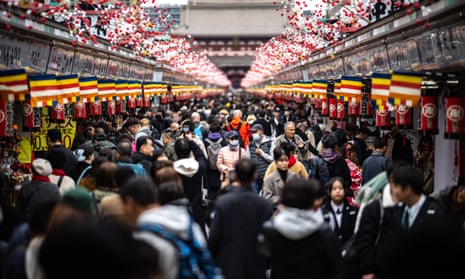

‘A free-for-all’: Japan divided as return of tourists brings Instagrammers and litter
A year after travel restrictions were lifted, authorities are straining to cope with millions of visitors, especially those who don’t respect the environment and local customs
At the height of the Covid pandemic, the restaurateurs and shopkeepers of Tsukiji market in Tokyo must have dreamed of days like these.
Columns of smartphone-wielding visitors shuffle along the narrow streets, pausing to inspect hand-forged kitchen knives and tsukemono pickles, and to sip gratis samples of green tea. Restaurants tempt the lunchtime crowd with sticks of grilled wagyu , boiled crab legs and, for dessert, plump strawberries encased in chewy mochi rice.
But there are indications that Tsukiji’s multinational clientele are not always on their best behaviour. Signs in English implore them not to eat outside storefronts or leave their litter behind. Staff hold aloft signs reminding diners where to queue for their 12-piece, ¥2,700 (£14.40) sushi lunch. Here, as in many other popular destinations around the world, booming tourism is a double-edged sword .
Almost a year after Japan lifted all pandemic travel restrictions, foreign visitors are back with a vengeance, drawn by a weak yen, world-beating cuisine, and the promise of a holiday of a lifetime in a country that was once considered a tourism backwater.
“Everything is cheap, the service is incredible, and the food is the best you’re going to have, and at a fraction of the price you’d pay in America,” said Tommy Buchheit, an American who was visiting Japan for the first time.
Those and other attractions tempted 25.8 million foreign visitors to Japan last year, according to immigration authorities – a sixfold rise from 2022. Together they spent a record ¥5.3tn (£28.3bn), according to the Japan Tourism Agency. Japan’s government wants more, setting an ambitious goal of 60 million visitors – and ¥15tn of spending – by the end of the decade.
But critics say Japan is ill prepared for higher tourist numbers, citing even more strain on accommodations, public transport and the service industry, at a time when the country is battling an acute labour shortage .
In his vision for a new “tourism nation”, prime minister Fumio Kishida said sustainable tourism depended on welcoming visitors without adversely affecting the quality of life for local people. Proposals outlined by the government last year include boosting the number of buses and taxis, raising public transport fares during peak hours, and opening new bus routes.
It also earmarked 11 “model” destinations, including rural eastern Hokkaido and the sub-tropical island of Okinawa, it hopes will draw visitors away from Tokyo, Osaka, and Kyoto, which together accounted for 64% of overnight stays by foreign visitors in the first eight months of last year. The stress will be less on consumption and more on cultural immersion, from experiencing mountain asceticism and Zen meditation, to making pottery and saké.

“Tourism pollution” is most visible in Kyoto, Japan’s ancient capital and home to some of the country’s most famous temples and shrines, and the geisha district of Gion. In 2022 the number of tourists visiting Kyoto exceeded 43 million – about 30 times the city’s population.
Peter MacIntosh, a longtime Canadian resident who organises geisha-themed walking tours, said residents were struggling to reconcile the disruption caused by hordes of visitors with a dramatic uptick in spending.
“The problem is that people here want the best of both worlds – to have a quieter life and make money – but it is only going to get worse as more people arrive. Kyoto is becoming a free-for-all,” said MacIntosh, who added that tour groups of up to 40 people were not unusual.
The boom has seen less well-known locations wrestling with travellers eager to gather social media content. They include a railway crossing in Kamakura, southwest of Tokyo, which has been inundated with fans of Slam Dunk , a popular manga comic and anime TV series about high school basketball. The crossing, which appears in the anime’s opening credits, is considered a “sacred site” among fans.
Some local authorities are taking matters into their own hands, amid concern that overtourism is damaging sites of historical and ecological interest.
Visitors to Itsukushima Shrine, a Unesco world heritage site, must pay ¥100 (53p) admission, while later this year, tourists heading to the Taketomi islands will be charged an as-yet undecided sum to help protect their pristine beaches.
From this summer, visitors planning to hike to the summit of Mount Fuji, another Unesco site, will be charged ¥2,000 (£10.70), as local authorities attempt to take the strain off crowded trails trodden by more than 5 million people in 2019.
“Japan has become a bucket-list destination,” said Karlÿn de Bruin, who was visiting Tokyo from the Netherlands with her father and brother. “I can imagine that local people get fed up, so we try to mind our own business. But you can feel the social media vibe … people dressing up and taking photos in certain ways because it makes good content.”
Kenichi Kondō, a Tsukiji fishmonger, was beaming as he served grilled fillets of black cod to hungry passersby. “Our takings are up tenfold compared to a couple of years ago,” said Kondō, whose business has occupied the same spot for more than 50 years. “First we had a lot of people from North America and Europe, but now they are mainly from Southeast Asia, and we’re expecting a lot of Chinese visitors when they celebrate their new year soon.”
While he welcomed the shot in the arm tourism has given his store’s 10 employees, Kondō conceded that littering had become a big problem. “We try to get around that by offering to take people’s rubbish off them if they buy our fish. There are exceptions, but the tourists here are generally well behaved.”
Lizzie Jones, an American on her fourth trip to Japan, was sanguine about the crowds she encountered at Tsukiji on an unseasonably warm February day. “You expect it when you do all the touristy things … when you come to this market you know it’s going to be packed.”
But like many locals, she took exception to litter louts and nuisance influencers who trample on local customs and treat busy locations like their personal photo studio.
“I think it’s a generational thing,” she said. “The first few times I came here, there was no trash and now there’s a lot. There’s also a sense of an entitlement … people do whatever they want and don’t teach themselves about local customs. They don’t care. These places don’t just exist for your Instagram story.”
- The Observer
- Asia Pacific
- Coronavirus
Most viewed
We've detected unusual activity from your computer network
To continue, please click the box below to let us know you're not a robot.
Why did this happen?
Please make sure your browser supports JavaScript and cookies and that you are not blocking them from loading. For more information you can review our Terms of Service and Cookie Policy .
For inquiries related to this message please contact our support team and provide the reference ID below.
America still has the world's busiest airport
- New data on the world's busiest airports in 2023 reveals the latest trends in global travel.
- 8.5 billion passengers traveled by plane last year, almost marking a return to pre-pandemic levels.
- Airports in Asia and the Middle East became busier, but the US has once again clinched the top spot.

International travel is almost back to pre-pandemic levels, according to the just-released list of the world's busiest airports in 2023.
8.5 billion passengers traveled globally by plane last year — up from 7 billion passengers in 2022 .
The rise in air travel marks a recovery to 93.8% of levels in 2019 before the world shut down, according to preliminary data published by the Airports Council International (ACI), a trade association that includes 2,600 airports worldwide.
Increasing travel to airports in Asia and the Middle East was one of the key trends to emerge from the data, with Dubai International Airport jumping from the fifth to the second busiest airport in the world.
Airports in India, Japan, and Turkey also made it into the top 10 and were some of the biggest movers in terms of annual gains in passenger numbers.
As the world's largest domestic market for flights , US airports still make up five of the busiest airports in the world, with Hartsfield-Jackson Atlanta International Airport retaining its No. 1 position.
Despite tough global economic conditions, there was "a growing inclination towards travel," Luis Felipe de Oliveira, the ACI's world director general, said in a press release.
"Airports continue to demonstrate their resilience and adaptability amidst the challenges posed by the ever-evolving landscape of global travel," said Oliveira.
Here's a closer look at the top 10 busiest airports in the world.
10. Indira Gandhi International Airport, Delhi, India
Passengers: 72.2 million
2022 ranking: 9th
Delhi's main airport, Indira Gandhi International Airport, saw a 21.4% increase in year-on-year traffic. While it has dropped a place this year, Delhi has grown significantly as a transport hub since 2019, when it sat at number 19 in the rankings.
9. Chicago O’Hare International Airport, USA
Passengers: 73.9 million
2022 ranking: 4th
Travel through Chicago O'Hare jumped by 8.1% throughout 2023. O'Hare is a hub airport for domestic travel, particularly for United and American Airlines flights. It is also a focus city for low-cost rivals Spirit Airlines and Frontier Airlines.
8. Los Angeles International Airport, USA
Passengers: 75.1 million
2022 ranking: 6th
Travel through LAX was up 13.8% in 2023, however, compared to pre-pandemic levels in 2019, passengers at the West Coast airport decreased by 14.8% — the largest decrease of any airport in the top ten rankings. LAX is a hub for a number of carriers, including Alaska Airlines, United, American, and Delta. But domestic travel at the airport shrunk dramatically as airlines cut the number of flights following a series of meltdowns in 2022.
7. Istanbul Airport, Turkey
Passengers: 76 million
2022 ranking: 7th
Passenger numbers at Turkey's Istanbul airport have increased by 18.3%, making it the only transit hub to keep level with its previous ranking in the top 10. Notably, traffic through the airport has jumped by 45.7% since 2019.
6. Denver International Airport, USA
Passengers: 77.8 million
2022 ranking: 3rd
Denver Airport has dropped down several places on the list but still shows strong signs of growth in terms of passengers. In the last year traffic through the Colorado airport was up 12.3%, and it has also grown 12.8% from pre-pandemic levels.
5. Tokyo Haneda International Airport, Japan
Passengers: 78.7 million
2022 ranking: 16th
Japan's Tokyo Haneda Airport saw the largest increase in traffic by far, with passenger numbers surging by 55.1%. Some of that jump can be explained by a lag in tourism as Japan only reopened its borders in late 2022. Despite the jump, Tokyo Haneda is still 7.9% under its 2019 level of traffic. This January the airport made headlines after a fatal collision involving a Japan Airlines plane and a coastguard vehicle killed five people.
4. London Heathrow, UK
Passengers: 79.2 million
2022 ranking: 8th
Travel through the UK's largest airport shot up by 218% in 2022 and has once again made strong gains throughout 2023, jumping by a slightly more modest 28.5%. The airport has credited travel from the Asia-Pacific region as a major factor in its increased passenger numbers. It hopes to supersede its pre-pandemic level of traffic in 2024 and hit a record 81.4 million passengers, the airport said in a report published in December.
3. Dallas/Fort Worth International Airport, USA
Passengers: 81.8 million
2022 ranking: 2nd
Dallas/Fort Worth airport , known as DFW, is American Airlines' busiest hub and the departure city for many of the airline's international flights. Last year traffic through the airport jumped by 11.4%.
2. Dubai International Airport, UAE
Passengers: 87 million
2022 ranking: 5th
Dubai took the number 2 ranking in the list for the first time, thanks to a significant 31.7% increase in passenger numbers. Dubai's new position reflects the heavy investment that has gone into the aviation industry and boosting tourism in the region.
1. Hartsfield-Jackson Atlanta International Airport, USA
Passengers: 104.7 million
2022 ranking: 1st
Hartsfield-Jackson Atlanta International Airport comes in at No. 1 as the busiest airport in the world, a position it has held for more than two decades. In 2023, the Atlanta airport saw an 11.7% increase in passenger numbers.
Here's a look at what it takes to be an air traffic controller at the world's busiest airport.
- Main content
Japan factory output likely rebounded in March, while retail sales held firm: Reuters poll
- Medium Text
Sign up here.
Reporting by Tetsushi Kajimoto; Editing by Tom Hogue
Our Standards: The Thomson Reuters Trust Principles. New Tab , opens new tab

Markets Chevron

Gulf bourses end mixed; Egypt extends decline
Stock markets in the Gulf put in a mixed performance on Sunday amid rising oil prices and receding hopes of rapid interest rate cuts by the U.S. Federal Reserve after a series of inflation readings.

We use cookies on this site to enhance your user experience. If you continue to browse you accept the use of cookies on our site. See our Cookie Policy for more information.
- Media & Industry
- Meetings & Events
- Muslim Guide
- Travel Trade
- Select Language 简体中文 繁體中文(香港) 繁體中文(臺灣) India (English) Bahasa Indonesia 한국어 ภาษาไทย Tiếng Việt Singapore (English) Philippines (English) Malaysia (English) Australia/New Zealand (English) Français Deutsch Italiano Español United Kingdom (English) Nordic countries(English) Canada (English) Canada (Français) United States (English) Mexico (español) Português العربية Japan(日本語) Global (English)
- India (English)
- Bahasa Indonesia
- Singapore (English)
- Philippines (English)
- Malaysia (English)
- Australia/New Zealand (English)
- United Kingdom (English)
- Nordic countries(English)
- Canada (English)
- Canada (Français)
- United States (English)
- Mexico (español)
- Global (English)
- Fujiyoshida
- Shimonoseki
- Ishigaki Island
- Miyako Island
- Kerama Island
- Tokyo Island
- Koka & Shigaraki
- Hida Takayama
- Ginza, Nihonbashi
- Beppu & Yufuin (Onsen)
- Ginzan Onsen
- Nagasaki Islands

- Kumano Kodo
- Shikoku Karst
- Amami Oshima
- Hachimantai
- Omihachiman
- Aizuwakamatsu

- Diving in Japan
- Skiing in Japan
- Seasonal Flowers in Japan
- Sustainable Outdoors
- Off the Beaten Track in Japan
- Scenic Spots
- World Heritage
- Home Stays & Farm Stays

- Japanese Gardens
- Japanese Crafts
- Temple Stays
- Heritage Stays
- Festivals and Events
- Theater in Japan
- Japanese Tea Ceremony
- Cultural Experiences in Japan
- Culture in Japan

- Local Cuisine Eastern Japan
- Local Cuisine Western Japan
- Local Street Food
- Japan's Local Ekiben
- Japanese Whisky
- Vegetarian and Vegan Guide
- Sushi in Japan Guide
- Japanese Sake Breweries

- Art Museums
- Architecture
- Performing Arts
- Art Festivals
- Japanese Anime and Comics
- Japanese Ceramics
- Local Crafts

- Scenic Night Views
- Natural Wonders
- Theme Parks
- Samurai & Ninja
- Iconic Architecture

- Wellness Travel in Japan
- Japanese Ryokan Guide
- A Guide to Stargazing in Japan
- Relaxation in Japan
- Forest Bathing (Shinrin-yoku)

- Experiences in Japan
- Enjoy my Japan
- National Parks
- Japan's Local Treasures
- Japan Heritage
- Snow Like No Other

Visa Information
- Getting to Japan
Airport Access
- COVID-19: Practical Information for Traveling to Japan
- Anime Tourism
- Countryside Stays
- Accessible Tourism
- Hokkaido Great Outdoors
- Scenic World Heritage in Tohoku
- Shikoku’s Nature and Traditions
- Southern Kyushu by Rail

- Traveling by Rail
- How to Travel by Train and Bus
- JR Rail Passes
- Scenic Railways
- Renting a Car
- Sustainable Travel in Japan
- Travel Brochures
- Useful Apps
- Online Reservation Sites
- Eco-friendly Accommodation
- Luxury Accommodations
- Traveling With a Disability
- Hands-free Travel
- How to Book a Certified Tour Guide
- Volunteer Guides
- Tourist Information Center

- Japanese Manners
- Spring in Japan
- Summer in Japan
- Autumn in Japan
- Winter in Japan
- Cherry Blossom Forecast
- Autumn Leaves Forecast

- Japan Visitor Hotline
- Travel Insurance in Japan
- Japan Safe Travel Information
- Accessibility in Japan
- Vegetarian Guide
- Muslim Travelers
- Safety Tips

- All New Stories
- The Latest Itinerary
- A Japan For You
- Area Travel Pass
- Travelers Blog
- Western Japan Sample Itinerary
- Tohoku Colors
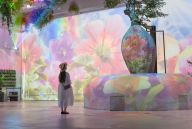
News from JNTO MY
- News from JNTO & Partners
- Newsletters (General Consumer)
- Newsletters (Partner Exclusive)
My Favorites
${v.desc | trunc(25)}
Planning a Trip to Japan?
Share your travel photos with us by hashtagging your images with #visitjapanjp
Go Beyond Japan’s Major Cities: Hokuriku Shinkansen Extension in 2024
Sakura and Beyond: Famous Japanese Flowers to Check Out in 2024
Awaken Your Inner Child at These Theme Parks in Japan
Destinasi Mesra Muslim
JAPAN Welcome Guide for Muslims
Important notice.
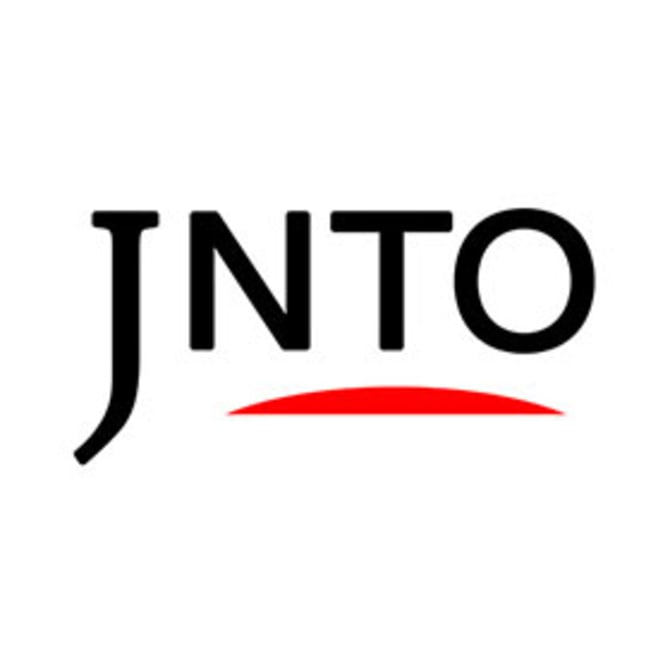
Delicious Japan
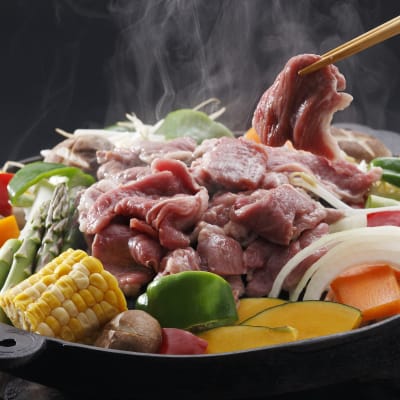
Latest Stories
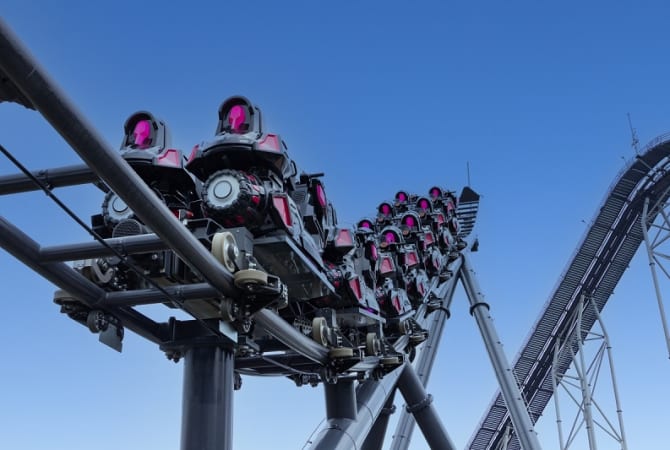
Travel Highlights
Popular places.
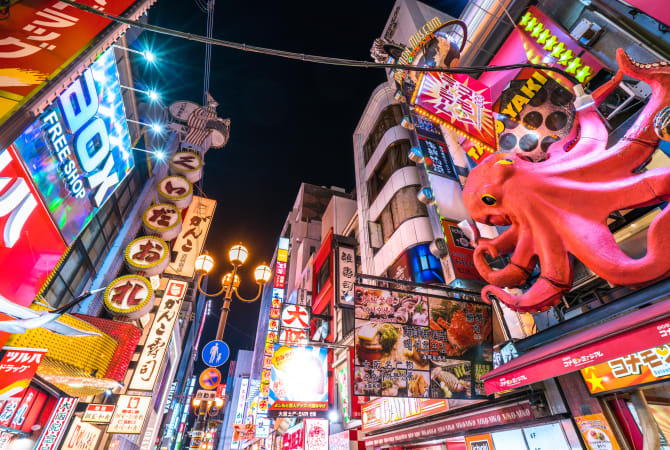
Explore by Interest
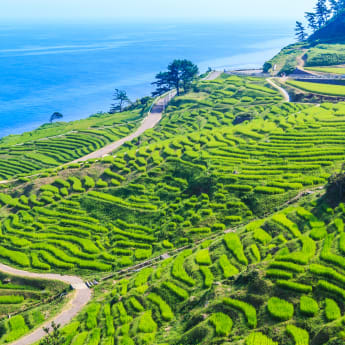
Mar 27, 2024

For First-Time Visitors
- Wi-Fi & Connectivity
- Weather & Geography
- IC Travel Cards
Where to Stay
- Luxury Stay
- Haneda Airport
- Narita Airport
- Osaka (KIX)
- Fukuoka Airport
Getting Around
- Shinkansen (Bullet Train)
- Luggage & Storage
Suggested Walks & Tours
- Tokyo 48 Hours
- Golden Route
- 2 Weeks in Japan
- Tour & Activities
Brochure Download
- Tours and Activities
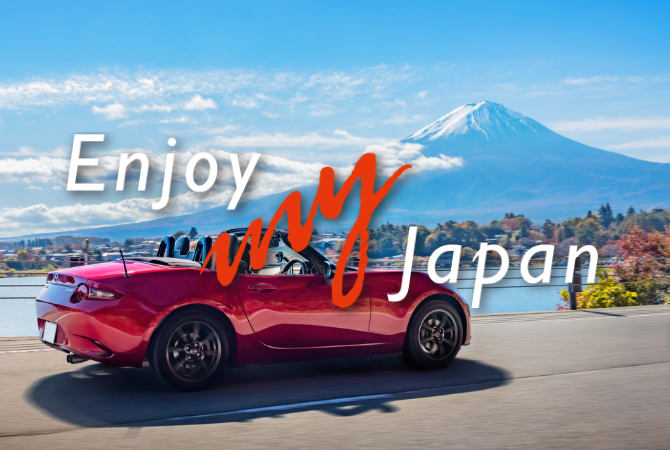
Japanese Government Information
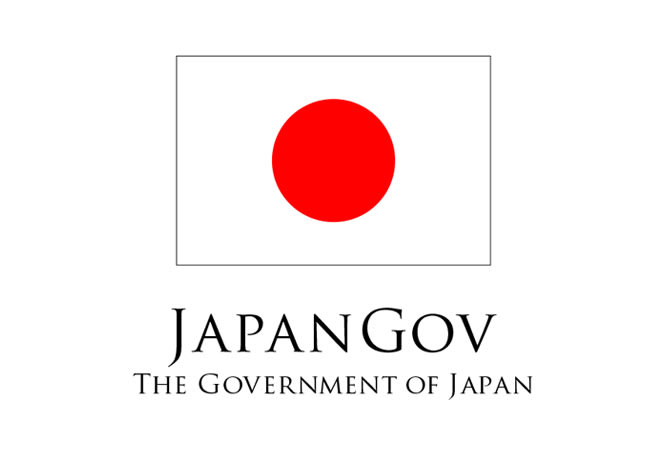
News from JNTO & Our Partners
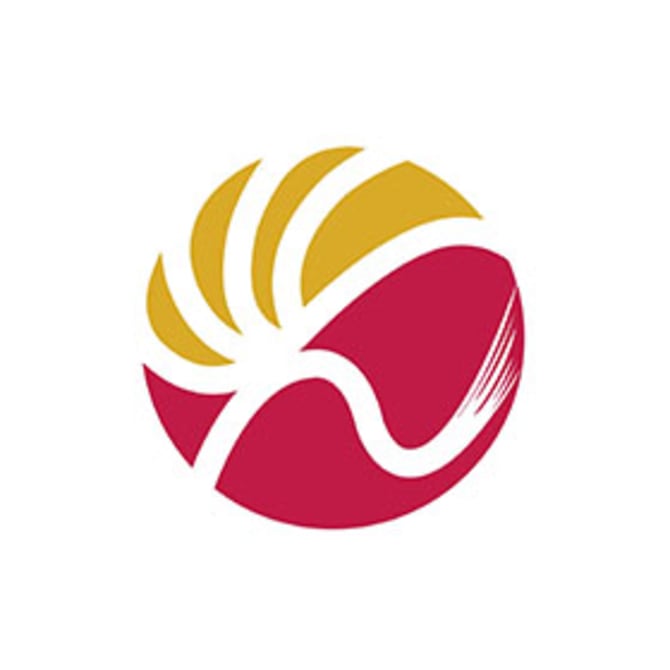
Please Choose Your Language
Browse the JNTO site in one of multiple languages

IMAGES
VIDEO
COMMENTS
The latest tweets from @Visit_Japan
The latest tweets from @JapanTravel
The official site of Japan National Tourism Organization is your ultimate Japan guide with tourist information for Tokyo, Kyoto, Osaka, Hiroshima, Hokkaido and other top Japan holiday destinations. We offer travel information to make your Japan travel more comfortable and enjoyable.
JNTO operates a visitor hotline 24 hours a day, 365 days a year. Call for tourist information or assistance in the case of accidents and emergencies including COVID-19. Support is available in English, Chinese and Korean. From Japan 050-3816-2787. From Overseas +81-50-3816-2787.
Japan launched an all-out effort to promote inbound tourism, and Kyoto experienced a surge in popularity among foreign visitors. ... Follow New York Times Travel on Instagram, Twitter and Facebook.
Official Japan National Tourism Organization, providing free advice and information to Travelers
Welcome to Japan. The U.S. Embassy and consulates in Japan are pleased to welcome U.S. citizen visitors back to Japan! We encourage you to follow us on Twitter and Facebook ().Travelers should also consider enrolling in the Smart Traveler Enrollment Program.. U.S. military members and family with SOFA status should contact their chain of command directly for guidance and adhere to the ...
CNN —. Japan, one of the world's last major holdouts during the pandemic, is dissolving its Covid-19 restrictions and opening the door back up to mass tourism. Beloved for its unique mix of ...
The latest tweets from @Japan_Tourism
This movie introduces the new essential steps ahead of an unforgettable travel in Japan. General Information. Japan: the Official Guide. Japan National Tourism Organization. General tourism information of Japan in multi languages. Climate, Healthcare, Money, Visa, Emergency info, etc.
In 2019, 9.2 million Chinese tourists travelled to Japan, accounting for nearly one-third of all visitors, spending 1.8 trillion yen ($12.2bn) in the process. "Our head office is located in the ...
Call us in Washington, D.C. at 1-888-407-4747 (toll-free in the United States and Canada) or 1-202-501-4444 (from all other countries) from 8:00 a.m. to 8:00 p.m., Eastern Standard Time, Monday through Friday (except U.S. federal holidays). See the State Department's travel website for the Worldwide Caution and Travel Advisories.
TOKYO, Oct 10 (Reuters) - (This Oct. 9 story has been corrected to add negative COVID-19 test condition in paragraph 13) As Japan throws open its doors to visitors this week after more than two ...
Tourism in Japan is a major industry and contributor to the Japanese economy. Foreigners visit Japan to see natural wonders, cities, historic landmarks, and entertainment venues. Japanese people seek similar attractions, as well as recreation and vacation areas. In 2019, Japan attracted 31.88 million international tourists. [1]
The latest tweets from @japan_tourism_s
A sign encouraging good behaviour among tourists at Tsukiji market in Tokyo. Photograph: Justin McCurry/The Observer "Tourism pollution" is most visible in Kyoto, Japan's ancient capital and ...
Record Tourist Numbers Are Clogging Up Kyoto's Public Transport. As more visitors head to Japan's ancient capital, public anger is rising and presenting its new mayor with a tough challenge. A ...
This movie vividly portrays the traditional, modern and natural attractions of Tokyo, Kyoto and other locations throughout Japan from a unique perspective.
International travel is almost back to pre-pandemic levels, according to the just-released list of the world's busiest airports in 2023. 8.5 billion passengers traveled globally by plane last year ...
The latest Tweets from Japan Travel (@japan_tourist): "覚えている、繰り返し、聞く、簡単な英語を学ぶ http://t.co/O7SpbFjHdn"
A senior figure in Japan's ruling party will travel to New York next week and is seeking a meeting with Republican presidential candidate Donald Trump, according to public broadcaster NHK.
Japan's factory output likely staged a strong rebound in March from the previous month's decline, with retail sales probably holding firm on booming inbound tourism and easing worry about weak ...
Kushiro & Hokkaido East. Gion & Higashiyama. Ishigaki Island. Around Fukuoka City. Kiyosato & Hokuto. Naha. Sendai City. Hiroshima City. Check out our Japan map, explore Japan's destinations and travel highlights in this comprehensive guide to where to visit in Japan.
Relaxation in Japan. Shopping in Japan. Action & Adventure in Japan. Art & Design in Japan. History in Japan. Japanese Nature. Japanese Festivals & Events. Food & Drink in Japan. Luxury.
The official Japan tourism website for Australians and New Zealanders by Japan National Tourism Organization (JNTO), the government tourism board. We use cookies on this site to enhance your user experience. If you continue to browse you accept the use of cookies on our site. See our Cookie Policy for more information.
Number of visitor arrivals to Japan March 2024. A Beautiful Garden Certified by the National Plant Collection Has Remained Unchanged for Over 100 Years! Azalea and Rhododendron Fair 2024 Held at Odakyu Hotel de Yama. JNTO is official Japan Tourism Organization, providing free advice and information to Malaysian Travellers.